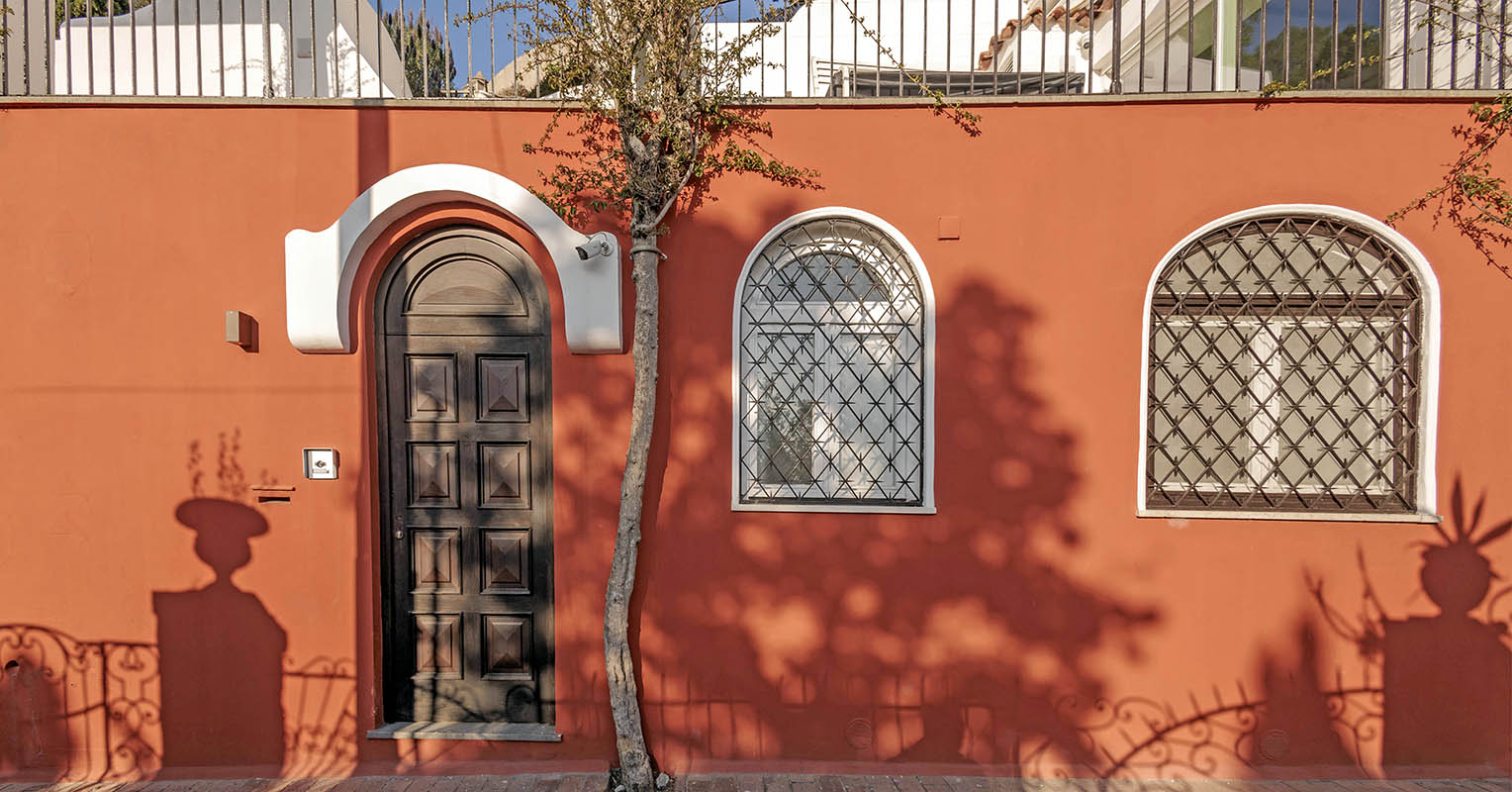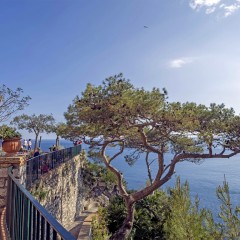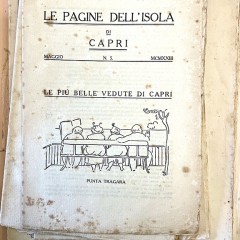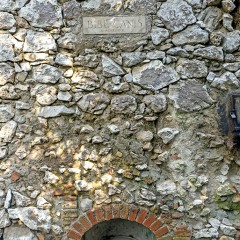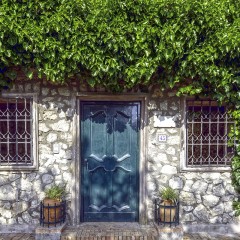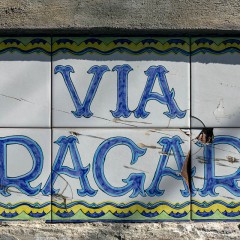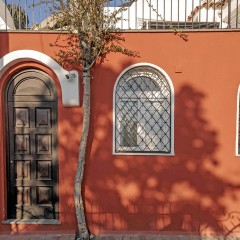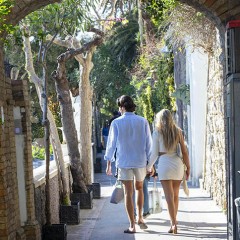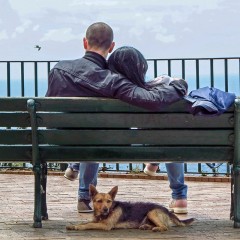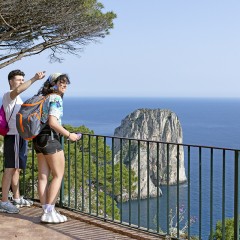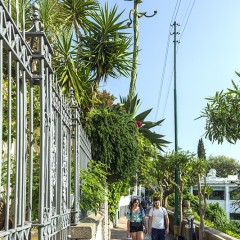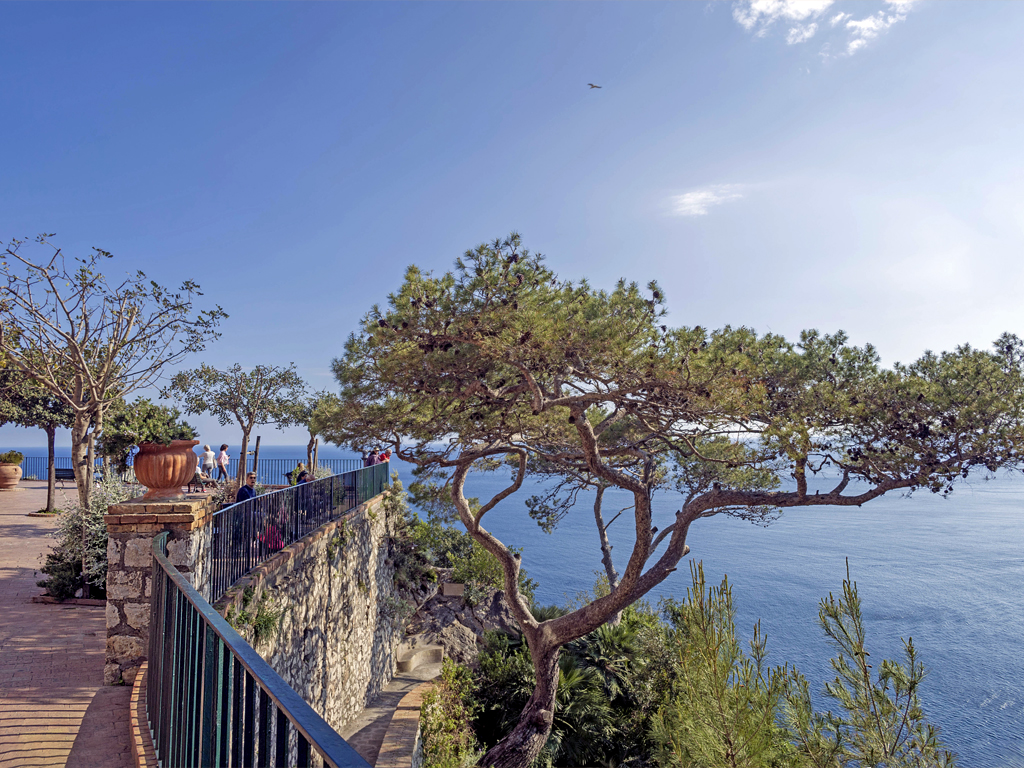
Tragara
Una passeggiata a mezza costa tra scorci di azzurro, motivi architettonici e il profumo dei fiori
foto di / photos by Raffaele Lello Mastroianni
Ada Negri, 1923
“Viandante, se vai fino a Punta Tragara,
argentea d’ulivi, prendi a sinistra,
un viottolo scavato a scaglioni nel sasso.
Aspro; ma verso il mare tutto oro
di folli ranuncoli, verso il monte tutto ombre di mirti,
e pensoso amaranto di cardi.
Ti condurrà alla casa che risponde,
marmoreo silenzio ai silenzi dell’aria”.
“Passerby, if you go up to Punta Tragara,
silvery with olive trees, turn left, and walk down
a lane carved into steps out of the rock.
It is rough; but towards the sea it is all gold
with multitudes of buttercups, while towards
the mountain it is all shadowy with myrtles
and the pensive purple of thistles.
It will lead you to the house that responds
with marble silence to the silences of the air.”
Circa 600 metri, passo in più passo in meno, danno vita a questa via che parte dove finisce la strada delle boutique e dello struscio e che, quasi per incanto sembra lontana dalla movida isolana.
Siamo a 125 metri sul livello del mare e costeggiamo il monte Tuoro in un continuo alternarsi di aperture sull’azzurro, scorci di verde e motivi architettonici. Il ricordo della colonizzazione greca sopravvive nel suo toponimo che significa “recinto o chiuso delle capre”, dal greco tragarion.
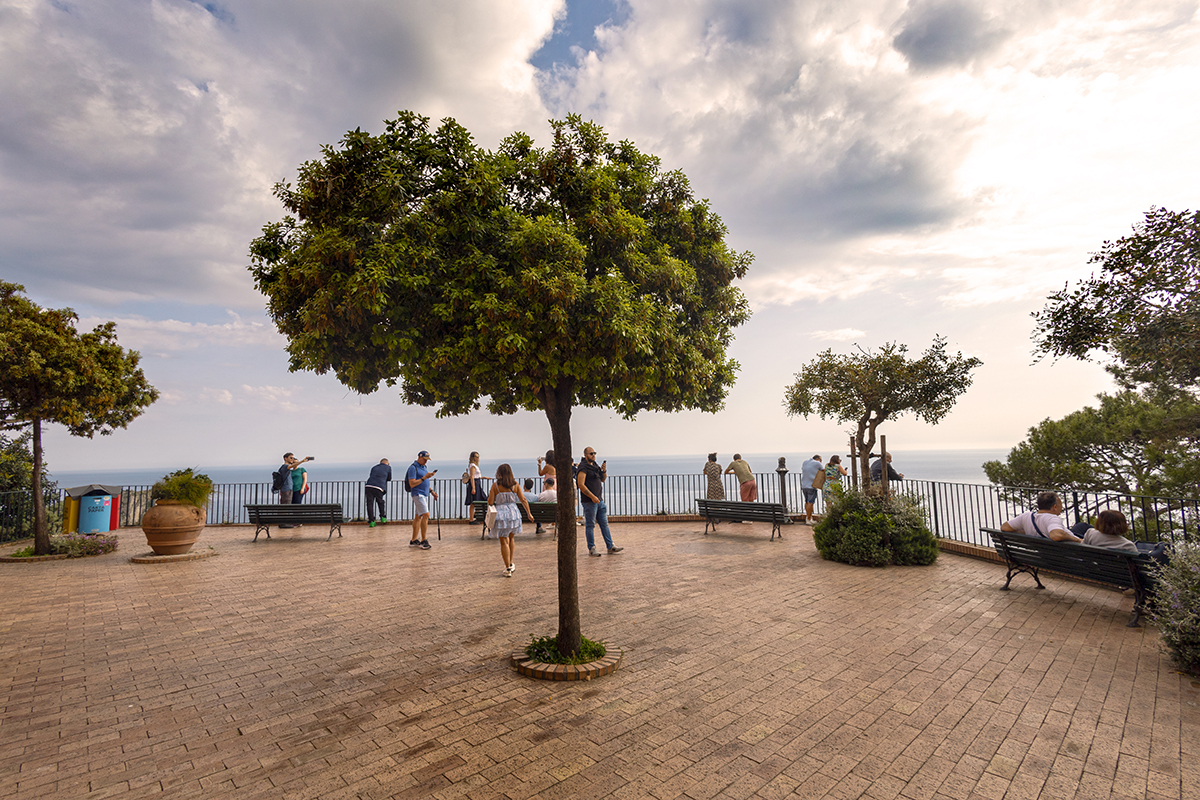 Qui la primavera regala qualche pergola di glicine in fiore e appena il sole si fa caldo esplodono le bouganville che colorano di fucsia più di un muro che resterà a lungo vestito dei fiori così poco amati da Edwin Cerio. Ingegnere, sindaco di Capri e figura di spicco della vita culturale dell’isola, dal 1949 fino alla sua morte avvenuta nel 1960, abitò con la moglie Claretta a Villa Lo Studio, al civico 19. Quasi di fronte, al 14, c’è Casa Arturo che ha visto tra gli ospiti illustri Pablo Neruda e Matilde Urrutia.
Qui la primavera regala qualche pergola di glicine in fiore e appena il sole si fa caldo esplodono le bouganville che colorano di fucsia più di un muro che resterà a lungo vestito dei fiori così poco amati da Edwin Cerio. Ingegnere, sindaco di Capri e figura di spicco della vita culturale dell’isola, dal 1949 fino alla sua morte avvenuta nel 1960, abitò con la moglie Claretta a Villa Lo Studio, al civico 19. Quasi di fronte, al 14, c’è Casa Arturo che ha visto tra gli ospiti illustri Pablo Neruda e Matilde Urrutia.
È tra queste mura che vissero la loro appassionata storia d’amore.
Ma tanti sono i nomi famosi che hanno abitato nelle ville che si affacciano su questa strada.
La regina Margherita di Savoia, il pittore e fotografo Morgan Heiskel, il poeta tedesco Rainer Maria Rilke a Villa Capricorno, il musicologo Camille du Locle e il barone Fersen a Villa La Certosella e il pittore tedesco Wilhelm Allers a Villa Tragara sono solo alcuni.
Luci, ombre, proporzioni, accostamenti di colori accompagnano gli eucalipti, i cipressi e le palme che mostrano le chiome svettare o far capolino dietro muri e cancelli di questa via silenziosa dove, nelle serate più calde l’aria odora di gelsomino.
In fondo quel belvedere che suscita sempre un sentimento di meraviglia, anche ai più assidui frequentatori. Qui lo sguardo si apre sull’azzurro del mare che si perde nel cielo e quelle rocce giù in fondo e il volo dei gabbiani sono di una bellezza a cui non ci sia abitua. Alla fine potrete scegliere di rimanere incantati in contemplazione oppure, seguendo il suggerimento di Ada Negri, scendere per quel viottolo scavato nella roccia. Anche dopo cento anni regala ancora belle emozioni.
Un suggerimento: fermatevi a respirare il profumo dei pini.
A walk over the hillside amid views of the sea, architectural motifs and the scent of flowers
The road is about 600 metres long, give or take a few steps; it starts where the main drag and the boutiques end, and, as if by magic, you suddenly feel far away from the hustle and bustle of the island.
We are 125 metres above sea level and we are walking around Monte Tuoro in a continuous alternation of vistas opening onto the blue sea, views of greenery and architectural motifs.
The memory of the Greek colonization survives in the place name, Tragara, which means “goat enclosure or pen”, from the Greek tragarion.
Here spring offers the sight of pergolas covered with wisteria in bloom, and as soon as the sun becomes hot, the bougainvillea bursts into flower, turning more than one wall fuchsia-coloured; the walls remain clad for many weeks in these flowers that Edwin Cerio so despised.
An engineer, mayor of Capri and a leading figure in the cultural life of the island, Cerio lived with his wife, Claretta, at Villa Lo Studio, at no. 19 on this road, from 1949 until his death in 1960. Almost opposite their house, at no. 14, is the Casa Arturo where some illustrious guests have stayed, including Pablo Neruda and Matilde Urrutia. It was here, between these walls, that the couple lived out their passionate love story.
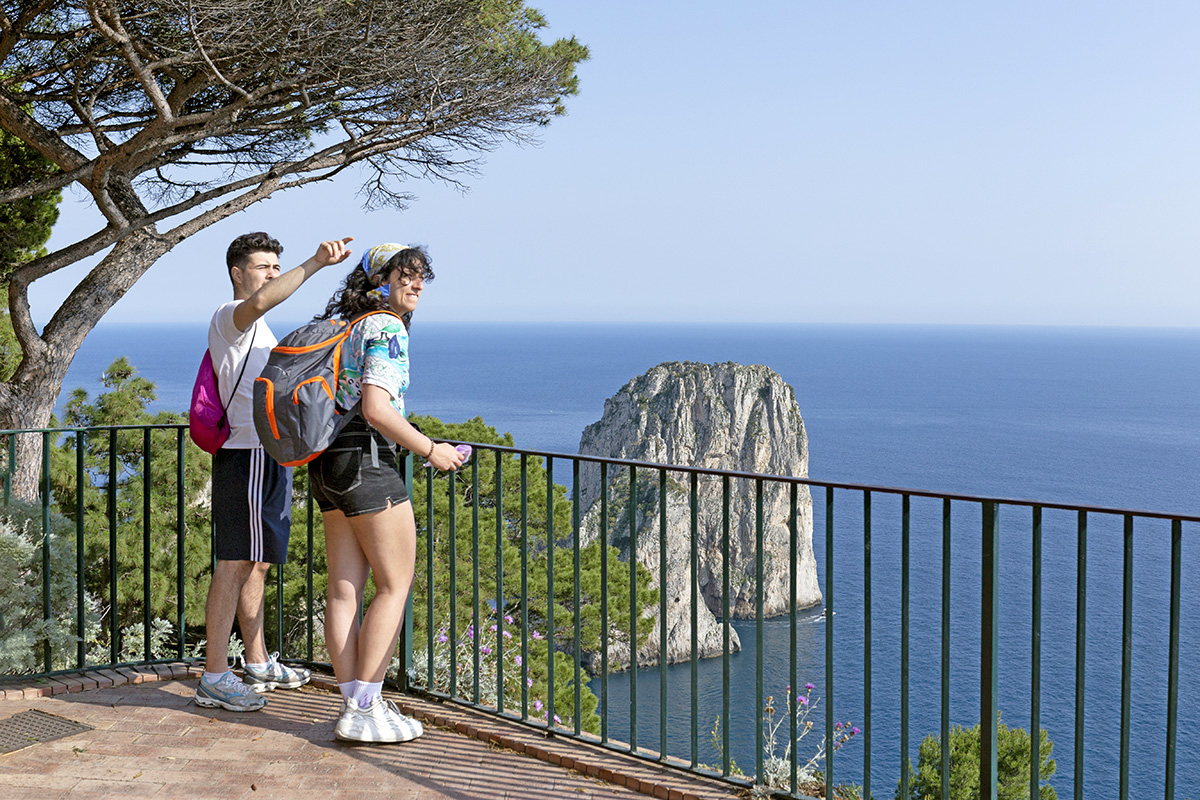 And there are many other famous names who have lived in the villas facing onto this road: Queen Margherita of Savoy, the artist and photographer Morgan Heiskel, the German poet Rainer Maria Rilke at Villa Capricorno, the musicologist Camille du Locle and Baron Fersen at Villa La Certosella and the German artist Wilhelm Allers at Villa Tragara, are just some of them.
And there are many other famous names who have lived in the villas facing onto this road: Queen Margherita of Savoy, the artist and photographer Morgan Heiskel, the German poet Rainer Maria Rilke at Villa Capricorno, the musicologist Camille du Locle and Baron Fersen at Villa La Certosella and the German artist Wilhelm Allers at Villa Tragara, are just some of them.
Light and shadow, graceful proportions and colour combinations accompany the eucalyptus, cypresses and palm trees, whose tops can be seen swaying in the breeze, or that may be glimpsed from behind walls and gates along this silent road where, on the hottest evenings, the air is perfumed with jasmine.
At the end of the road stands the belvedere that never fails to invoke a feeling of wonder, even in those who come here most often. Here the view opens out onto the deep blue of the sea which loses itself in the sky, and those rocks down below and the wheeling of the seagulls have a beauty that you never become inured to. At the end of the road, you can choose to stay there in enchanted contemplation or, following Ada Negri’s suggestion, walk down that path, cut into the rock. Even after a hundred years, it still stirs beautiful emotions. One suggestion: stop for a while to breathe in the scent of the pines.


